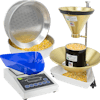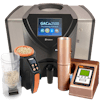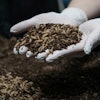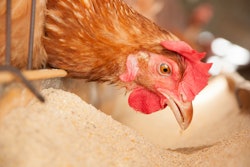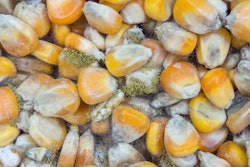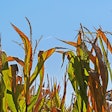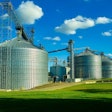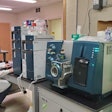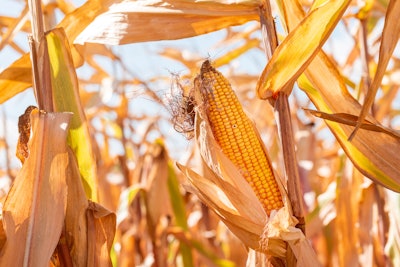
Cargill已经发布了2022 World Mycotoxin Reportthat features a large, comprehensive mycotoxin contamination database with more than 300,000 analyses run from around the globe each year.
Healthy animals perform better and drive better productivity for livestock farmers and producers, which is whyproactive risk managementis vital in the battle against mycotoxins and microfungi found in grain that can cause disease and death.
Despite the lack of visible symptoms, mycotoxins can wreak havoc on animal health and performance under the surface. For instance, mycotoxins can weaken the immune system and degrade nutrient absorption and vaccine response.
If symptoms appear from mycotoxin exposure, it's an indication that the animal has been exposed to high levels of mycotoxins for a long time, and the producer faces costly measures to reverse the impact.
Comprehensive mycotoxin data
Producers need comprehensive data on contaminants and their risks to decide whether mitigating measures, like feed additives, are necessary.
Cargill's 2022 World Mycotoxin Report is said to be the feed industry's most comprehensive data set on the regional prevalence of contaminants in common grains used in animal feed, and their risks to bovine, poultry or swine specifically.
The report contains more than 300,0000 mycotoxin analyses taken from 150 feed plants, on-farm samplings and storage locations, provides info on the most problematic mycotoxins with their level of contamination and performance risk rates, and species sensitivity when exposed to a given mycotoxin.
“Our aim is to make the most comprehensive and trusted information available on mycotoxin risk to help livestock farmers protect the health of their animals and operations,” says Gilles Houdart, global additive category director for Cargill's animal nutrition business.
“With the Cargill World Mycotoxin Report, farmers and feed producers can directly benefit from Cargill’s unique global footprint of animal nutrition expertise.”
Global mycotoxin trends
- Contamination is the rule: In 2022, 75% of the 300,000+ mycotoxin analyses conducted were positive and above detection limits. Also, the more mycotoxins you test for, the more you will find. For example, of samples tested for six mycotoxins, 84% were positive for four or more mycotoxins.
- Performance risk rates increased. Beyond the number of positive samples, it is important to consider contamination levels that may create a risk of reduced performance. For example, in 2022, 39% of analyses were above Cargill Performance Risk Threshold, representing a 4% increase from 202
- Mycotoxins to watch:Fumonisin (FUM), vomitoxin (DON) and zearalenone (ZEN) remain the top three mycotoxins of concern above Cargill performance risk thresholds. Over the past year, ZEN analyses above performance risk increased to 51% while FUM and DON remained elevated at 40% and 62%, respectively.
Ingredient trends
- Corn:75% of corn-based ingredients (including all by-products) analyses were positive for at least one mycotoxin, and 39% were above Cargill performance risk thresholds. DON (63%), ZEN (55%), FUM (44%), and T2 (33%) were most frequently above performance risk levels in corn group analyses.
- Cereals: 81% of cereal-based ingredients analyzed were positive for at least one mycotoxin, and 44% were above Cargill performance risk thresholds. In 2022, DON (66%), ZEN (31%), T2 toxin (T2) (28%), and Aflatoxin (AFL) (25%) were most frequently above performance risk levels in cereal group analyses.
- Oilseeds: 64% of oilseeds-based ingredients analyses were positive for at least one mycotoxin, and 22% were above Cargill performance risk thresholds. ZEN (64%), T2 (24%), and AFL (15%) were most frequently positive amongst analyses and presented the highest over Cargill performance risk thresholds. Oilseeds had the lowest contamination concern.
Regional mycotoxin trends around the world
Regions with the highest mycotoxin prevalence and risk levels include China, Asia, North America and Europe. Conversely, the Middle East and Africa (MEA), Central and South America and Russia show lower risk, though Russia (+11%) and MEA (+9%) have increased overall risk rates.
- Asia: AFL remained the highest risk in cereals and FUM in corn-based ingredients.
- Central and South America: Mycotoxins from Fusarium molds (ZEN, FUM, DON) represented significant risks for corn and cereals-based ingredients.
- China: Main concern was DON, ZEN and FUM in corn; DON and ZEN in cereals and ZEN in oilseeds.
- North America: DON remained a concern in corn and ZEN levels increased, particularly in the Northeast corn belt. FUM levels remained high in the Southern corn belt.
- Europe: DON still represented a high risk in cereals and corn-based ingredients. ZEN risk also increased in oilseeds.
- MEA: Increased overall risk with a 9% jump in the region from 2021. Substantial increases in ZEN, T2, FUM, and DON, to a lower extent, particularly in corn.
- Russia: Russia remains the region with the lowest mycotoxin rate; however, in 2022, we observed an 11% increase from 2021. T2, DON and ZEN contamination rates all doubled.
Species trends
Bovine: DON and ZEN are most important to watch out for performance consideration in all regions. AFL is also a critical one, particularly in Asia, for dairy, calf and heifer.
Poultry: FUM and ZEN are the two big culprits in most regions. Other culprits are DON (China, America, Europe), T2 (MEA, Europe, NA, Russia) and AFL (mainly Asia). It's important to consider ZEN as impacting all subspecies (and not only breeders or layers) and DON, which can impair growth performance even with a few hundred ppb.
Swine:和嬉笑the two big villains in most regions. Other culprits are AFL in Asia and T2 in Russia and Africa. It's essential to pay attention to ZEN levels as we see an increase vs. last year. ZEN impacts reproduction parameters for sow and can lower growth performance for all species with severe effects when combined with other mycotoxins.
What is the right approach to manage mycotoxins for my operation?
In addition to the risk management data provided in the report, Cargill has developed a first-of-its-kind Mycotoxin Impact Calculator (MIC) to address this question.
This in-house tool is the latest in Cargill's toolbox to help us and customers identify and mitigate mycotoxins with data-backed insights to maximize performance and outcomes for animals and producers' bottom line.
"Our customers need real-time actionable data to help them make sound decisions for their business. Thanks to our data centralization efforts and decision-making tools, Cargill helps to characterize mycotoxin risk for each situation to adopt the appropriate solution," says the author of the report, Clement Soulet, global additive category manager for Cargill's animal nutrition business.
The complete 2022 World Mycotoxin Report can be found athereor by emailingmycotoxins@cargill.com.

